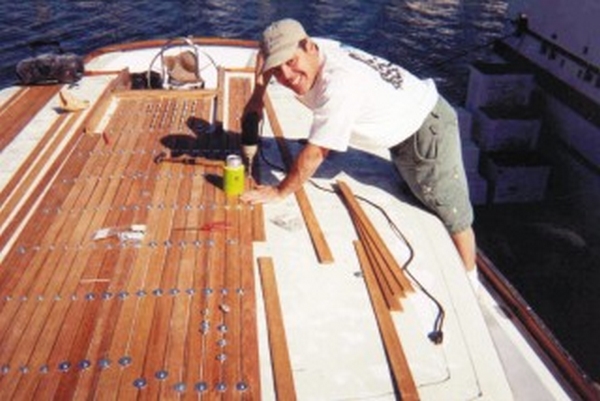AlxJ64
Rust is Paint
My ex father-in-law, Tim, was helping me out on installing some flooring in my old truck project but that was a few years ago and things went sideways.
The boards are ripped 5/8" thick Teak deck boards from the Battleship BB-55 North Carolina. They were removed in the '90s and stored. Originally there were only 5 boards available so had to rip them to get the coverage possible to veneer the rear floor of the truck.
The boards were sawn, fit, and laid out on a piece of 5/8" thick marine grade MDF. Tim's idea was to essentially use flooring glue to attach them to the MDF and that way the entire floor was one big panel that I could pull in and out of the truck as needed. It also reduced the chances of the boards moving around individually due to the sheet metal floor of the truck having some deflection properties.
We got it all done and attached to the panel, but the flooring glue was not curing right. Let it sit over the weekend and still not much. So I put it in my storage unit and there it sat for a few months as I was working on other things.. came in and moved it one day and all but one of the boards pretty much fell off the thing. That was in 2019. In the meantime I got divorced, moved, blah blah, and am finally back to working on the truck.
So... I am wondering, was the flooring glue just the wrong stuff? He looked at the tubes and it was several, if not 10 years old so maybe thinking it went bad.
I would rather find a mechanical means to attach these but I don't want a bunch of exposed hardware. There are two rows of seats that also go into this thing, and they are installed with keys that allow the seats to be moved around into various arrangements.
Suggestions on methods to attach these boards to this deck and then the seat key hardware will hold the whole thing into the back of the truck? Try again with the glue thing?







The boards are ripped 5/8" thick Teak deck boards from the Battleship BB-55 North Carolina. They were removed in the '90s and stored. Originally there were only 5 boards available so had to rip them to get the coverage possible to veneer the rear floor of the truck.
The boards were sawn, fit, and laid out on a piece of 5/8" thick marine grade MDF. Tim's idea was to essentially use flooring glue to attach them to the MDF and that way the entire floor was one big panel that I could pull in and out of the truck as needed. It also reduced the chances of the boards moving around individually due to the sheet metal floor of the truck having some deflection properties.
We got it all done and attached to the panel, but the flooring glue was not curing right. Let it sit over the weekend and still not much. So I put it in my storage unit and there it sat for a few months as I was working on other things.. came in and moved it one day and all but one of the boards pretty much fell off the thing. That was in 2019. In the meantime I got divorced, moved, blah blah, and am finally back to working on the truck.
So... I am wondering, was the flooring glue just the wrong stuff? He looked at the tubes and it was several, if not 10 years old so maybe thinking it went bad.
I would rather find a mechanical means to attach these but I don't want a bunch of exposed hardware. There are two rows of seats that also go into this thing, and they are installed with keys that allow the seats to be moved around into various arrangements.
Suggestions on methods to attach these boards to this deck and then the seat key hardware will hold the whole thing into the back of the truck? Try again with the glue thing?

